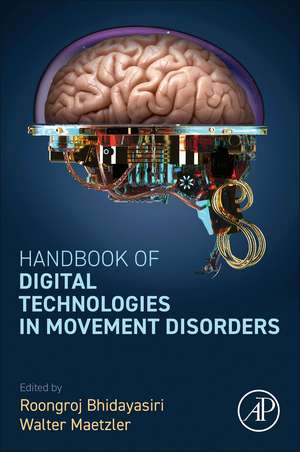Handbook of Digital Technologies in Movement Disorders
Editat de Roongroj Bhidayasiri, Walter Maetzleren Limba Engleză Paperback – 24 ian 2024
- Reviews different stakeholders' perspectives on technology in movement disorders
- Presents technological advancements for diagnosing, monitoring, and managing Parkinson’s disease
- Discusses challenges with implementing technology into treatment
Preț: 707.20 lei
Preț vechi: 882.11 lei
-20% Nou
Puncte Express: 1061
Preț estimativ în valută:
135.37€ • 147.09$ • 113.78£
135.37€ • 147.09$ • 113.78£
Carte tipărită la comandă
Livrare economică 14-28 aprilie
Preluare comenzi: 021 569.72.76
Specificații
ISBN-13: 9780323994941
ISBN-10: 0323994946
Pagini: 364
Dimensiuni: 216 x 276 mm
Editura: ELSEVIER SCIENCE
ISBN-10: 0323994946
Pagini: 364
Dimensiuni: 216 x 276 mm
Editura: ELSEVIER SCIENCE
Cuprins
Part 1: Digital technology: The primer
1. Digital technology: A multifacet discipline
2. Understanding medical and technical terminologies
3. Potential role of digital technologies in the management of PD: Unmet needs for diagnosis, monitoring and treatment
4. Parkinson’s disease and other movement disorders for technologists
Part 2: Different stakeholders` perspectives on technology in movement disorders
5. Technology in movement disorders: patients` points of view and expectations
6. Technology in movement disorders: medical professionals` points of view and expectations
7. Which technology is available, what is in the pipeline?
8. Novel analysis approaches
Part 3: Technology in movement disorders: detecting disease, measuring progression and determining response to treatment
9. Technologies for Diagnosis of Parkinson’s disease
10. Technologies for monitoring of Parkinson’s disease
11. Technologies for management of other movement disorders (chorea, dystonia, gait disorders, etc)
Part 4: Technology in movement disorders: Treatment
12. Assistive technologies
13. Robotic technologies in movement disorders
14. Closed loop systems
Part 5: Challenges and future directions
15. The optimal digital health record: Implementation of technology
16. Challenges ahead: Harmonization of (digital) datasets, privacy and other ethical issues
1. Digital technology: A multifacet discipline
2. Understanding medical and technical terminologies
3. Potential role of digital technologies in the management of PD: Unmet needs for diagnosis, monitoring and treatment
4. Parkinson’s disease and other movement disorders for technologists
Part 2: Different stakeholders` perspectives on technology in movement disorders
5. Technology in movement disorders: patients` points of view and expectations
6. Technology in movement disorders: medical professionals` points of view and expectations
7. Which technology is available, what is in the pipeline?
8. Novel analysis approaches
Part 3: Technology in movement disorders: detecting disease, measuring progression and determining response to treatment
9. Technologies for Diagnosis of Parkinson’s disease
10. Technologies for monitoring of Parkinson’s disease
11. Technologies for management of other movement disorders (chorea, dystonia, gait disorders, etc)
Part 4: Technology in movement disorders: Treatment
12. Assistive technologies
13. Robotic technologies in movement disorders
14. Closed loop systems
Part 5: Challenges and future directions
15. The optimal digital health record: Implementation of technology
16. Challenges ahead: Harmonization of (digital) datasets, privacy and other ethical issues
